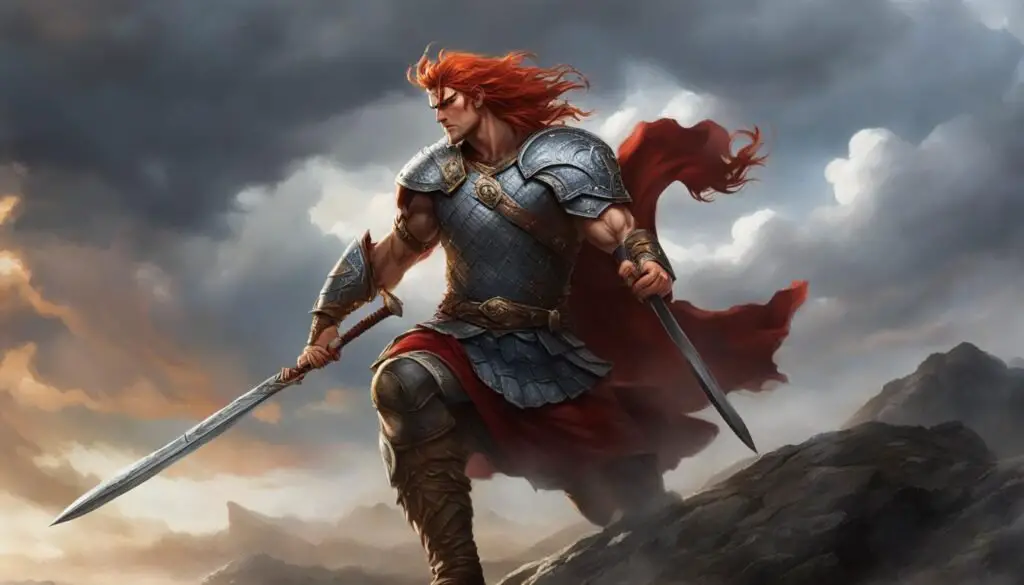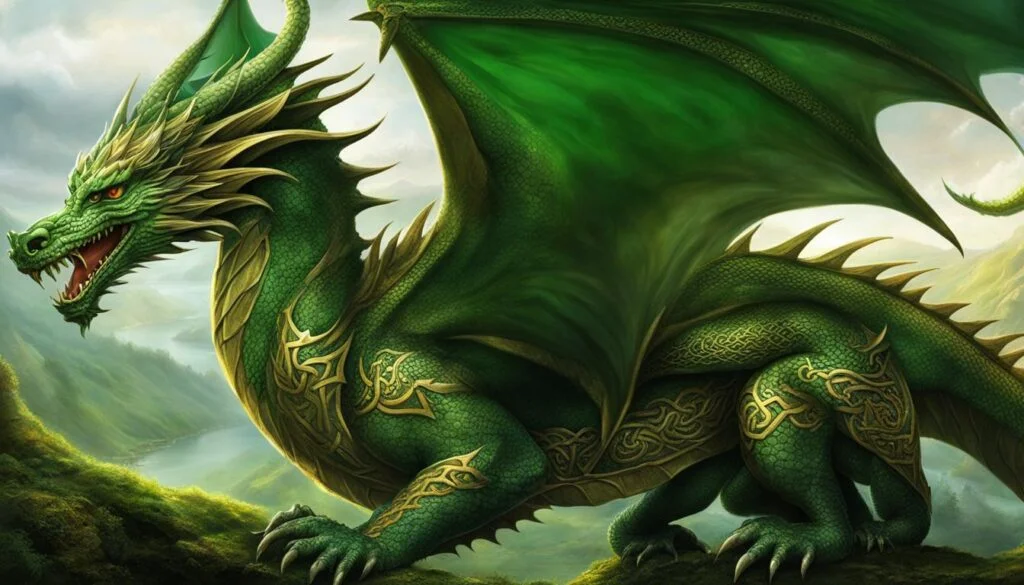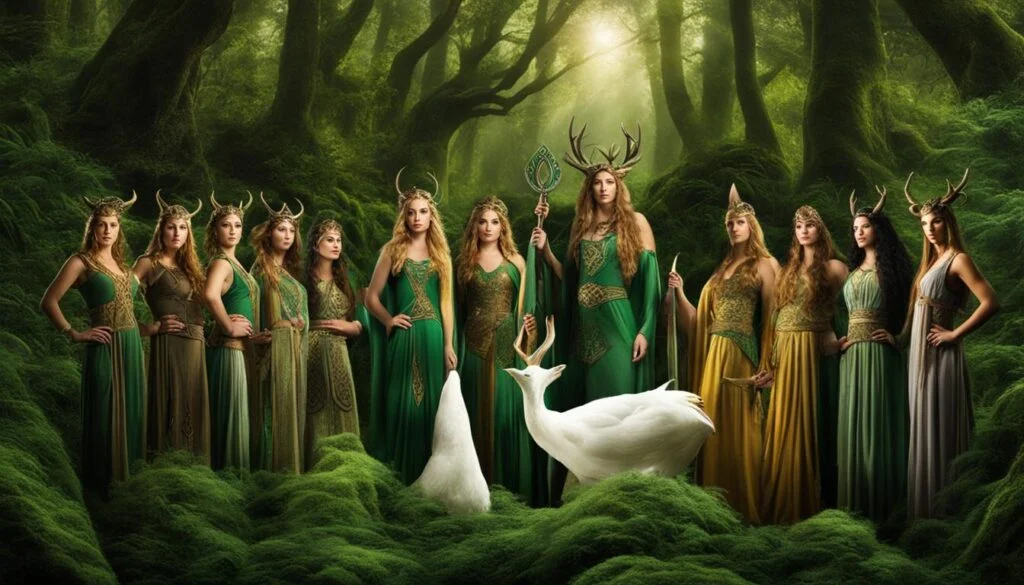Welcome to our exploration of Cú Chulainn, the iconic warrior and mythical hero of Irish legends. Cú Chulainn is a prominent figure in Irish mythology, particularly in the Ulster Cycle, where he is known for his famous deeds and extraordinary abilities. Let’s delve into the captivating stories and rich folklore that surround this legendary Irish hero.
Key Takeaways:
- Cú Chulainn is a legendary figure in Irish mythology, known for his iconic status as an Irish hero.
- His famous deeds and exceptional skills are celebrated in numerous Cú Chulainn stories.
- The Ulster Cycle is the collection of tales, featuring Cú Chulainn, that are deeply rooted in Irish folklore.
- Cú Chulainn’s battle prowess, battle frenzy, and unwavering commitment to defending Ulster make him a larger-than-life persona.
- His role in Irish culture and his enduring influence are testaments to the power of mythology in shaping cultural identity.
The Birth and Name of Cú Chulainn
Cú Chulainn’s miraculous birth is the subject of various legends. In one version, his mother Deichtine, the daughter of king Conchobar mac Nessa, assists in the birth of a baby boy while a mare gives birth to twin colts. The house and its occupants disappear, but the child and the colts remain. In another version, Deichtine herself gives birth to a son named Sétanta at a feast thrown by Culann, who made spears for King Conor. When Sétanta arrives late, Culann’s hound attacks him, but he kills the hound in self-defense. He offers to take the place of Culann’s hound and becomes known as Cú Chulainn, the Hound of Culann.
Cú Chulainn’s Childhood and Training
As a child, Cú Chulainn displayed extraordinary skills and quickly gained recognition among the Red Branch Knights, the esteemed army of King Conor Mac Nessa. His exceptional strength and agility impressed everyone, not only on the battlefield but also in various games such as hurling. His early prowess laid the foundation for his future as a legendary warrior.
Recognizing Cú Chulainn’s potential, he embarked on a journey to the land of Alba (Scotland) to train with the renowned warrior-woman, Scáthach. Under her expert tutelage, Cú Chulainn honed his martial arts skills and acquired invaluable knowledge. It was during his training with Scáthach that he received the legendary spear known as Gáe Bulg, a weapon of immense power and precision.
Cú Chulainn’s childhood experiences and intensive training shaped him into a formidable warrior, equipped with both physical prowess and strategic thinking. His journey of self-discovery and skill development played a pivotal role in his rise to becoming one of the most revered figures in Irish mythology.
The Red Branch Knights
The Red Branch Knights, also known as the Knights of the Red Branch, were an elite military order in ancient Ireland. They served as the prestigious army of King Conor Mac Nessa and were renowned for their strength, skill, and unwavering loyalty. Cú Chulainn’s inclusion among the Red Branch Knights at such a young age is a testament to his exceptional abilities and his potential as a future warrior.
Gáe Bulg: The Legendary Spear
Gáe Bulg, meaning “barbed spear,” is a weapon of great significance in Irish mythology. It was bestowed upon Cú Chulainn during his training with Scáthach. The spear had unique properties, including barbs that caused unhealable wounds, making it a formidable and feared weapon on the battlefield. Its association with Cú Chulainn further solidifies his reputation as an unparalleled warrior.
The Battle Frenzy and Famous Deeds of Cú Chulainn
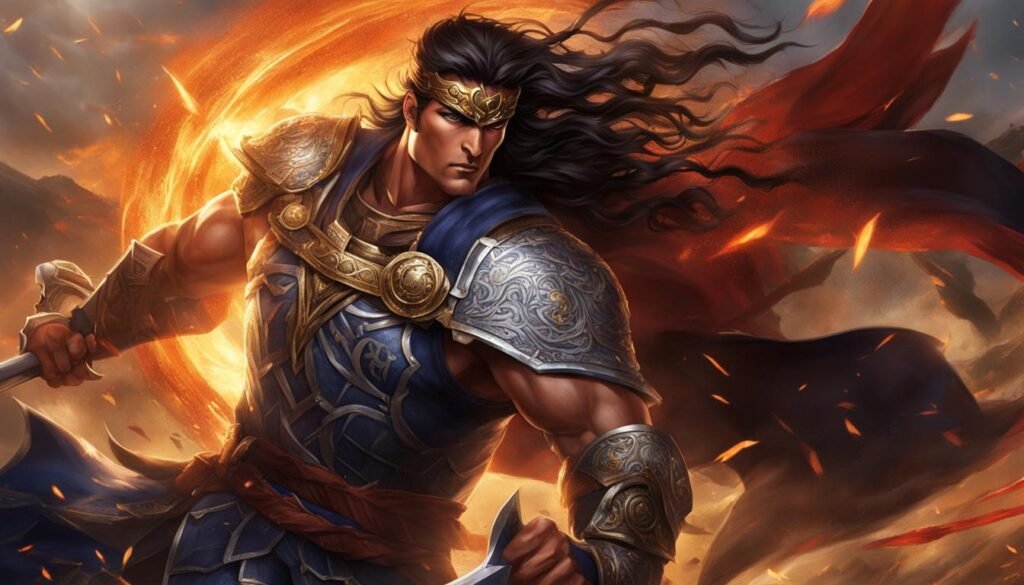
Cú Chulainn, the iconic warrior of Irish mythology, was known for his battle frenzy, igniting fear and awe in those who faced him on the battlefield. During this “ríastrad,” he transformed into a fearsome and unrecognizable monster, unleashing his unmatched strength and skill.
One of Cú Chulainn’s most famous deeds was his defense of Ulster against the armies of Queen Medb of Connacht in the epic saga known as the Táin Bó Cúailnge, or the Cattle Raid of Cooley. Single-handedly, he stood against overwhelming odds, overcoming adversaries with his legendary prowess.
Notably, Cú Chulainn encountered the water goddess Morrigan and the heroic warrior Loich, proving his mettle and determination. His unwavering dedication to protecting Ulster and his ability to overcome seemingly insurmountable obstacles earned him a place among the legendary figures of Irish mythology.
Famous Deeds of Cú Chulainn:
- Defending Ulster against Queen Medb’s armies in the Táin Bó Cúailnge
- Overcoming adversaries such as Morrigan and Loich
- Displaying unmatched strength, skill, and determination
Cú Chulainn’s Personal Life and Relationships
While Cú Chulainn is married to Emer, he is not without other romantic connections. His personal life and relationships add depth to his character and reveal the challenges he faces in his journey. One notable lover is Aífe, with whom he shares a son named Connla. However, their tragic story takes a devastating turn as Cú Chulainn is forced to kill Connla on the battlefield. The complexity of Cú Chulainn’s personal life paints a vivid picture of the emotional turmoil he experiences alongside his heroic exploits.
Discovering the intricacies of Cú Chulainn’s relationships allows us to delve further into his persona, revealing the multifaceted nature of this legendary figure. The tragic loss of his son Connla serves as a poignant reminder of the sacrifices and tragedies that often accompany great heroism.
Cú Chulainn’s Death and Legacy
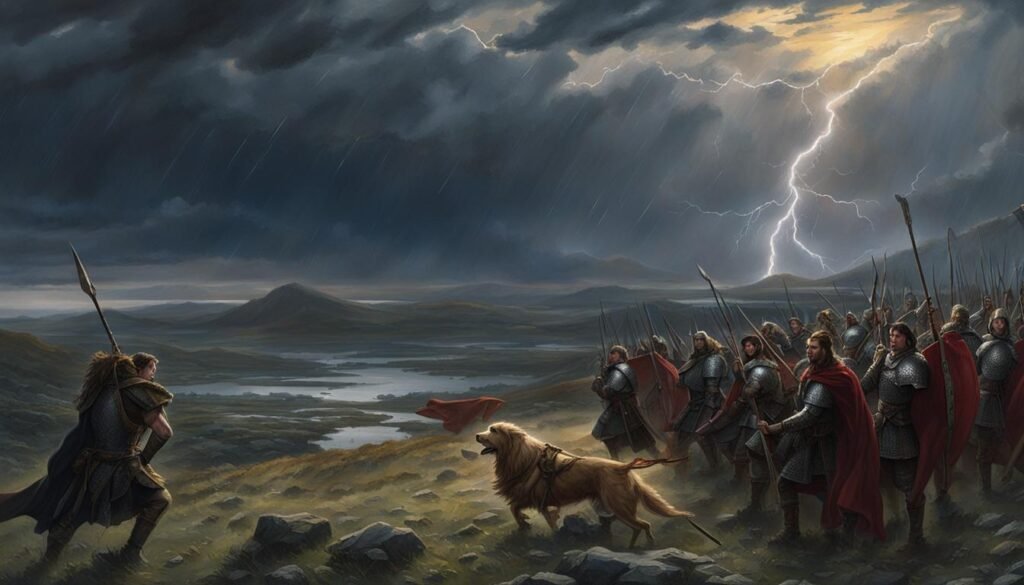
Cú Chulainn, the legendary Irish warrior, met his final fate on the battlefield. Mortally wounded by his own spear, he chose not to succumb lying down like any ordinary warrior would. Instead, he bound himself to a standing stone, symbolizing his unwavering determination to die on his feet.
His enemies, in awe of his fierce spirit, dared not approach him until a raven perched on his shoulder, marking the end of his valiant struggle. This symbolic moment solidified Cú Chulainn’s status as a Gaelic hero and an enduring symbol of Irish nationalism.
The death of Cú Chulainn marked the passing of a legendary figure, but his legacy lives on through his remarkable stories and his profound impact on Irish folklore. His courageous deeds and unwavering loyalty to his people continue to inspire generations, showcasing the power of mythology in shaping cultural identities.
The Legend of Cú Chulainn in Irish Folklore
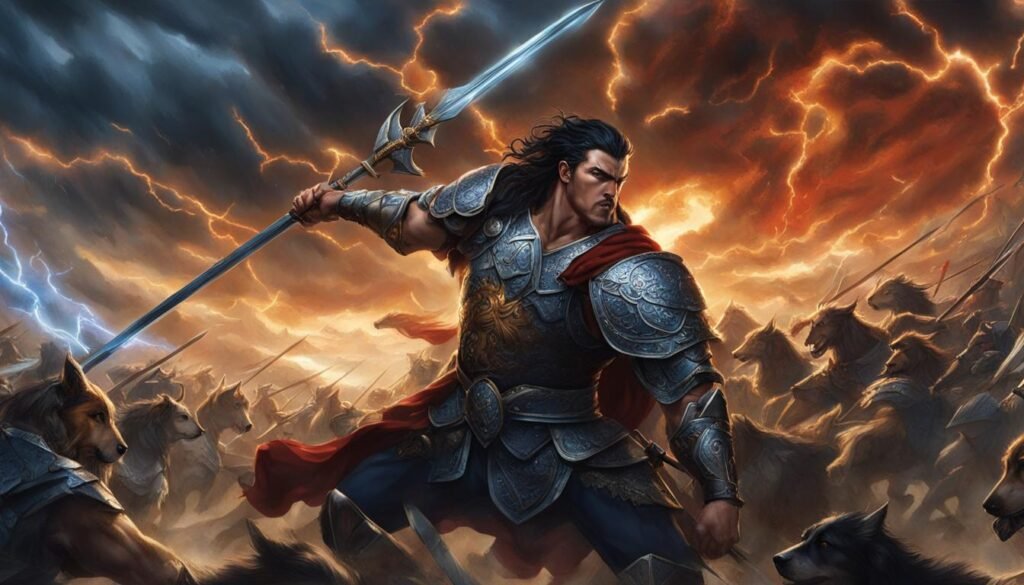
The legend of Cú Chulainn holds a significant place in Irish folklore, captivating audiences for generations with its tales of heroic feats and larger-than-life adventures. Passed down through centuries via oral storytelling, this ancient legend was later written down in the Táin Bó Cúailnge over 800 years ago. Today, the story continues to be taught in schools and remains a popular subject of study and fascination.
Oral storytelling played a crucial role in preserving the legend of Cú Chulainn, allowing it to be shared and cherished across generations. The vivid and dramatic tales recount the heroic exploits of this remarkable figure, his unparalleled strength, unrivaled battle skills, and legendary bravery. These stories, often accompanied by captivating performances, have enthralled listeners for centuries, weaving their way into the fabric of Irish cultural heritage.
The epic known as the Táin Bó Cúailnge, or the Cattle Raid of Cooley, serves as a primary source for the legend’s written documentation. This ancient saga chronicles Cú Chulainn’s adventures as he defends Ulster against Queen Maeve of Connacht’s armies in a quest to obtain the legendary Brown Bull of Cooley. The epic story showcases the courage, determination, and unwavering spirit of the iconic Irish hero.
The enduring popularity of the legend of Cú Chulainn can be attributed to its rich narrative, captivating characters, and themes that resonate with audiences of all ages. In addition to being a thrilling tale of heroism and adventure, the legend also explores deeper themes such as honor, loyalty, sacrifice, and the human capacity for both greatness and fallibility.
Today, the legend of Cú Chulainn continues to be celebrated, studied, and embraced as a vital part of Irish folklore. Its influence can be seen in various forms of artistic expression, including literature, poetry, music, and visual arts. The enduring legacy of this legendary Irish hero serves as a testament to the power of storytelling and its ability to shape cultural identities and inspire generations.
Cú Chulainn’s Name and Meanings
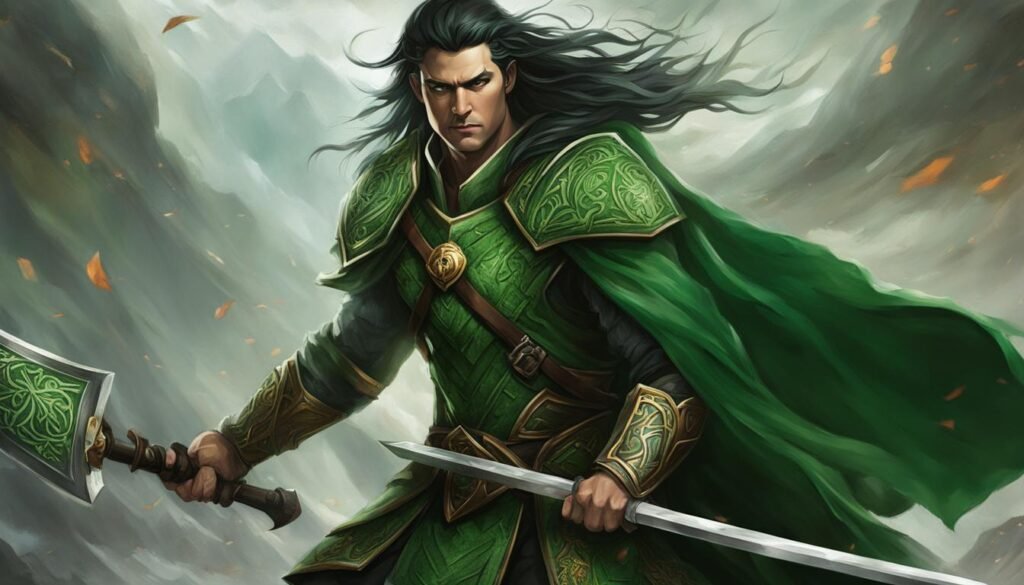
Cú Chulainn’s name holds great significance in Irish mythology. It is commonly interpreted as “Culann’s hound,” referencing the event when he killed Culann’s guard dog. However, the name has deeper connotations. In early Irish literature, “Cú” can also mean “warrior,” leading to alternative interpretations such as “Culann’s warrior” or “chariot-warrior.” These variations in the name add layers of complexity to Cú Chulainn’s character and the symbolism surrounding him.
The Táin Bó Cúailnge: The Epic Tale of Cú Chulainn
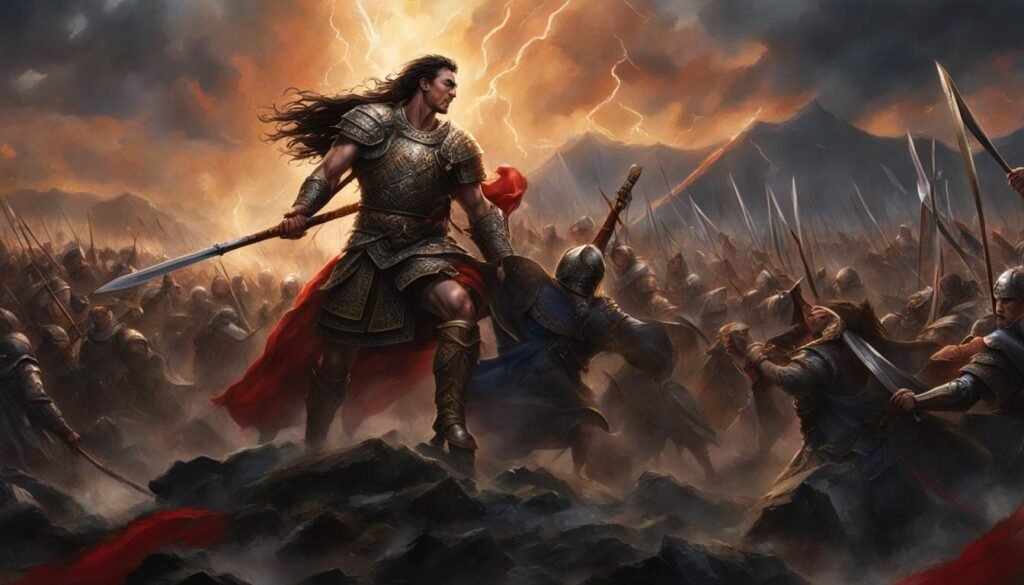
The Táin Bó Cúailnge, or the Cattle Raid of Cooley, is an ancient Irish saga that features Cú Chulainn as its central hero. This epic saga revolves around the conflict between Queen Maeve of Connacht and King Conor McNessa of Ulster over the possession of the Brown Bull of Cooley.
Cú Chulainn, with his exceptional bravery and skill in battle, plays a pivotal role in defending Ulster from the armies led by Queen Maeve. The tale showcases his unwavering dedication to protect his homeland and the lengths he goes to ensure victory in the face of overwhelming odds.
- Queen Maeve’s relentless pursuit of the Brown Bull of Cooley drives the narrative of the Táin Bó Cúailnge.
- Cú Chulainn’s heroic feats and strategic prowess captivate the audience as he confronts numerous adversaries on the battlefield.
- His legendary reputation as an iconic warrior is solidified through his valiant efforts in the midst of this epic conflict.
Throughout the saga, the clash between Queen Maeve and Cú Chulainn embodies the struggle for power, honor, and the protection of one’s people. The Táin Bó Cúailnge exemplifies the essence of Irish mythology and reinforces Cú Chulainn’s status as a revered figure in Irish folklore.
Cú Chulainn’s Influence on Irish Landscapes and Culture
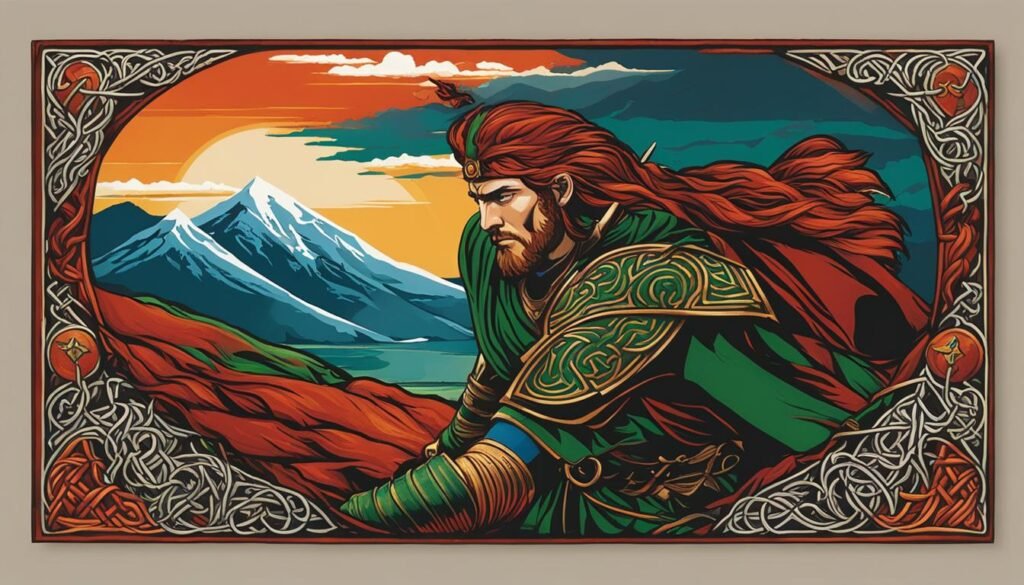
Cú Chulainn’s legendary status has had a profound impact on Irish landscapes and culture. His tales and exploits continue to inspire and captivate people, shaping the rich history and mythology of Ireland.
Clochafarmore Standing Stone
The Clochafarmore Standing Stone, situated outside Dundalk in County Louth, holds a special significance in Cú Chulainn’s story. This ancient stone is believed to be the very stone to which Cú Chulainn bound himself before meeting his end in battle. It stands as a tangible reminder of his heroic deeds and the enduring influence he has had on Irish culture.
Navan Fort
Navan Fort, known as Emain Macha in Irish mythology, was the ancient capital of Ulster and an important location associated with Cú Chulainn’s story. This archaeological site showcases the rich history and mythology of Ireland, where tales of the iconic warrior resonate through the rolling landscapes.
These sites, alongside others connected to Cú Chulainn, serve as a testament to his enduring presence in Irish culture. They stand as reminders of the profound impact of his legendary status and continue to draw visitors who seek to immerse themselves in the history and mythology that Cú Chulainn represents.
Conclusion
Cú Chulainn, the iconic warrior of Irish legends, has left an indelible mark on Irish mythology and folklore. His famous deeds and larger-than-life persona have earned him a prominent place in the hearts and minds of the Irish people. From his miraculous birth as Sétanta to his transformation into Cú Chulainn, the Hound of Culann, his journey is fraught with adventure, tragedy, and triumph.
Throughout his life, Cú Chulainn displayed incredible valor and skill, defending Ulster single-handedly against the armies of Queen Medb of Connacht. His battle frenzy, known as ríastrad, made him a fearsome force on the battlefield. His heroics in the Táin Bó Cúailnge, the epic saga of the Cattle Raid of Cooley, showcased his unwavering dedication to protect his homeland.
Cú Chulainn’s legacy extends beyond his martial prowess. His relationships, including his marriage to Emer and tragic encounter with his son Connla, reveal the complexity of his character. His tales of bravery and sacrifice continue to captivate audiences, highlighting the power of mythology in shaping cultural identity.
As an iconic figure in Irish folklore, Cú Chulainn is forever immortalized in the hearts of the Irish people. His legendary status serves as a reminder of the rich heritage and enduring spirit of Ireland. From his birth to his death, Cú Chulainn’s story resonates with audiences, solidifying his place among the greatest heroes of Irish legends.
FAQ
How is Cú Chulainn depicted in Irish legends?
Cú Chulainn is depicted as an iconic warrior and demigod in Irish mythology. He is known for his famous deeds in the Ulster Cycle and is considered a mythical hero in Irish folklore.
What are Cú Chulainn’s most famous deeds?
Cú Chulainn’s most famous deeds include defending Ulster single-handedly against the armies of queen Medb of Connacht in the Táin Bó Cúailnge (Cattle Raid of Cooley) and his terrifying battle frenzy known as ríastrad.
How is Cú Chulainn’s birth and name significant in Irish mythology?
Cú Chulainn’s birth is the subject of various legends, and his name translates to “Culann’s hound.” The incident where he killed Culann’s guard dog led to his name change and his association with the Hound of Culann.
What is Cú Chulainn’s background and training?
Cú Chulainn was born Sétanta and later joined the Red Branch Knights, where he displayed exceptional skills. He then traveled to Scotland to train with the warrior-woman Scáthach, where he learned martial arts and received the legendary spear Gáe Bulg.
What are some of Cú Chulainn’s famous deeds and battles?
Cú Chulainn’s most famous deed is defending Ulster against Queen Medb’s armies in the Táin Bó Cúailnge. He overcame numerous adversaries, including the water goddess Morrigan and the hero Loich, showcasing his exceptional bravery and skill in battle.
What is Cú Chulainn’s personal life like?
Cú Chulainn is married to Emer but has many other lovers. With Aífe, he fathers a son named Connla, whom he tragically kills in battle. Cú Chulainn’s personal relationships add depth to his character and contribute to the complexities of his story.
How does Cú Chulainn meet his end?
Cú Chulainn dies in battle, binding himself to a standing stone symbolizing his wish to die on his feet. His enemies are afraid to approach him until a raven lands on his shoulder, signifying his death.
What is the significance of Cú Chulainn in Irish mythology and folklore?
Cú Chulainn is an iconic figure in Irish folklore and is considered a symbol of Irish nationalism. His legendary status and famous deeds have made him an enduring figure in Irish culture.
How does Cú Chulainn’s name hold meaning in Irish mythology?
Cú Chulainn’s name translates to “Culann’s hound” but also holds other meanings such as “warrior” and “chariot-warrior.” The variations in his name add depth to his character and the symbolism surrounding him.
What is the Táin Bó Cúailnge?
The Táin Bó Cúailnge, also known as the Cattle Raid of Cooley, is an ancient saga in Irish mythology that features Cú Chulainn as its central hero. It revolves around the conflict between Queen Maeve of Connacht and King Conor McNessa of Ulster over the possession of the Brown Bull of Cooley.
How has Cú Chulainn influenced Irish landscapes and culture?
Cú Chulainn’s influence can be seen in various Irish landscapes, such as the Clochafarmore Standing Stone associated with his death. Additionally, sites like Navan Fort showcase the rich history and mythology connected to Cú Chulainn.


